Abstract
Counts of total viable, aerobic, heterotrophic bacteria, indicator organisms, and Aeromonas spp. were made at a diver training site on the Anacostia River in Washington, D.C. The numbers of Aeromonas cells in Anacostia River sediment and water increased during periods of elevated water temperature, to maxima of 4 × 105 cells per g of sediment and 300 cells per ml of water. Correspondingly, Aeromonas counts dropped 2 to 4 logs as the water temperature decreased to 0 to 0.5°C. Cultures taken by sterile swabs from the ears and face masks of divers after a 30-min swim in the Anacostia River yielded bacterial types and numbers similar to those found in the river. The nasal passages of the divers apparently did not become contaminated by swimming, possibly because of the protective effect of the face masks used by the divers. Properties associated with virulence in Aeromonas hydrophila and Aeromonas sobria strains isolated from the river, sediment, and divers were investigated. Nearly 40% of the strains of both species collected during the study produced cytotoxic activity for mouse Y-1 adrenal cells, as well as elastase. Enterotoxin activity, as detected by the Y-1 assay, was observed in 3% (1 of 35) of the strains of A. sobria and in 6% (19 of 330) of the A. hydrophila strains. Fluid accumulation in rabbit ileal loops induced by both species of Aeromonas varied greatly among the 17 strains examined. Fluid accumulation of at least 0.4 ml/cm was correlated with positive cytotoxin- or enterotoxin-like response in the Y-1 tissue culture assay.
Full text
PDF


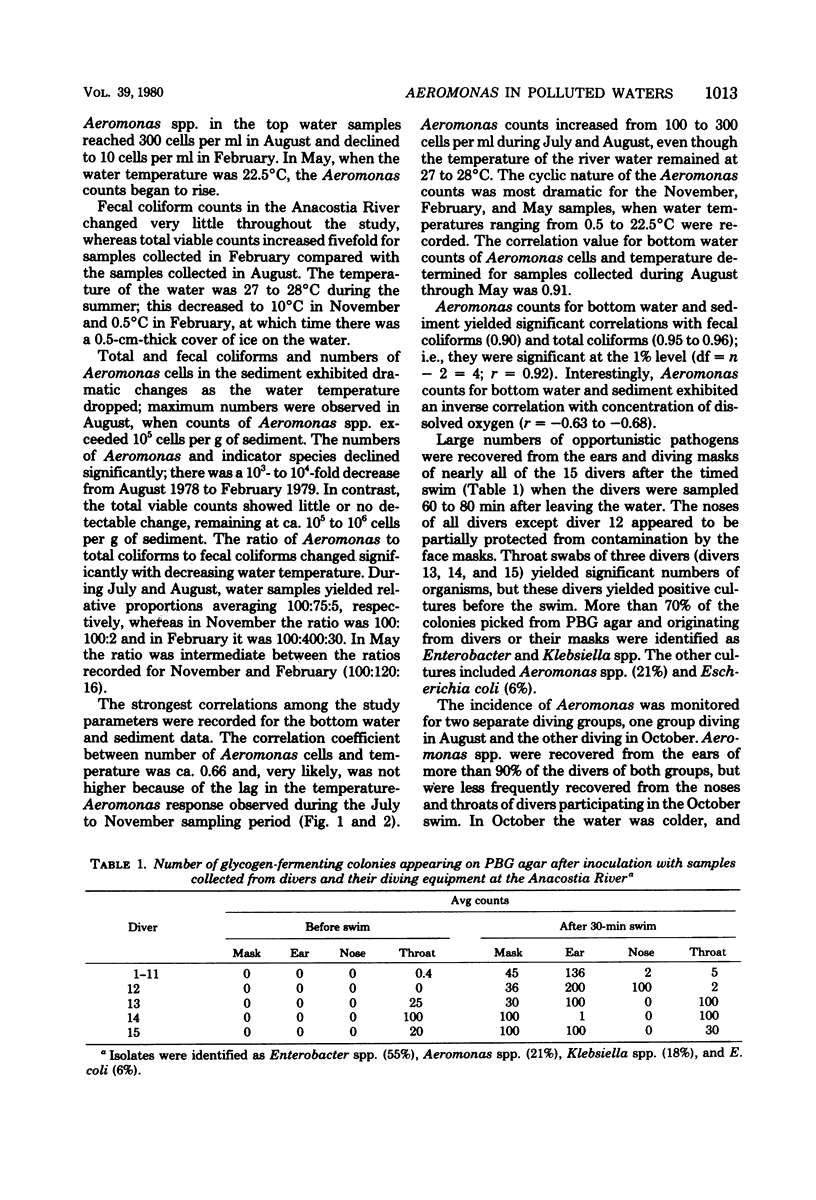
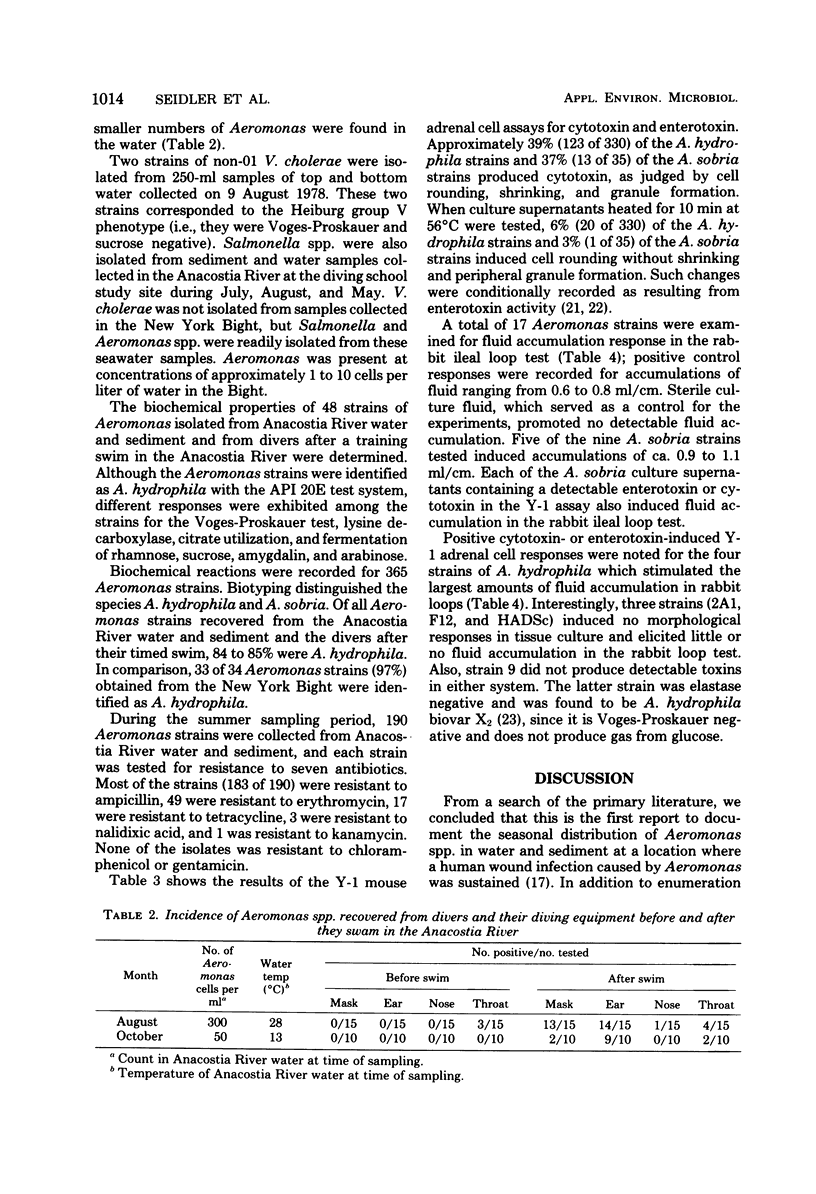
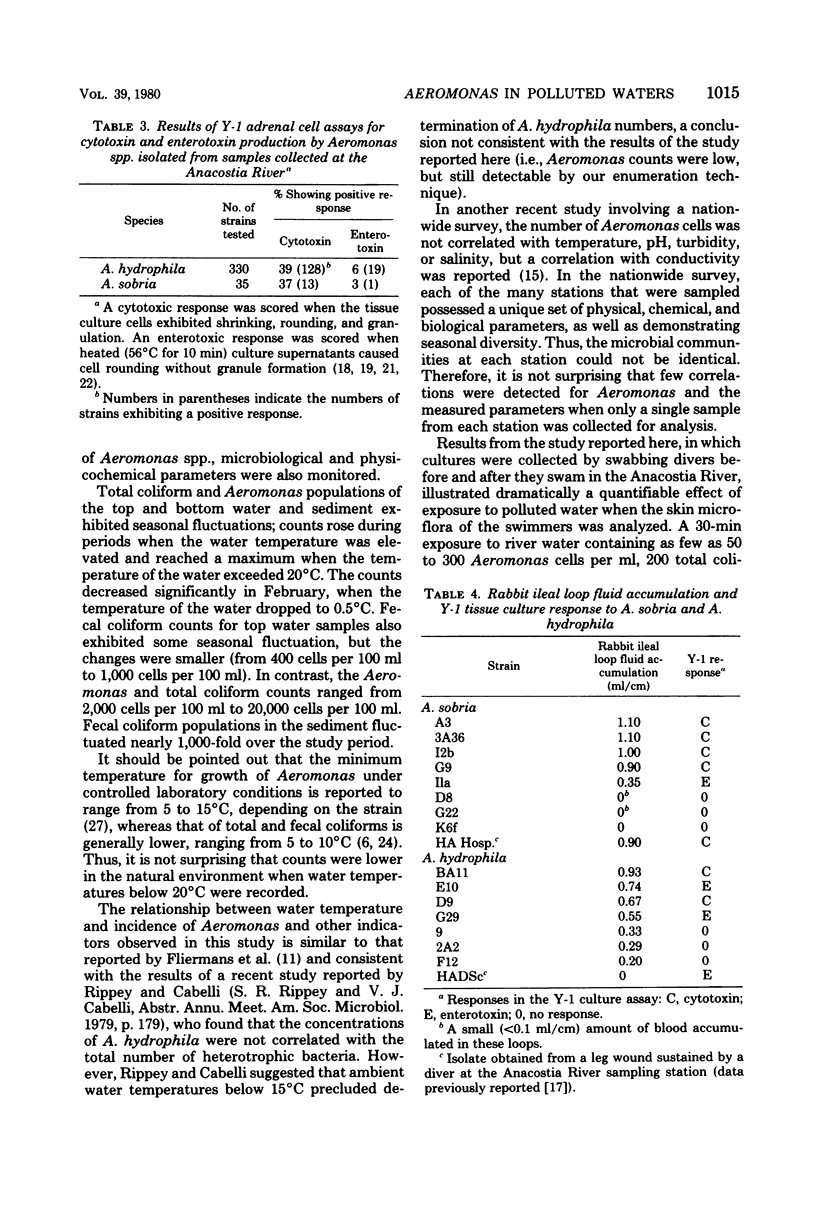
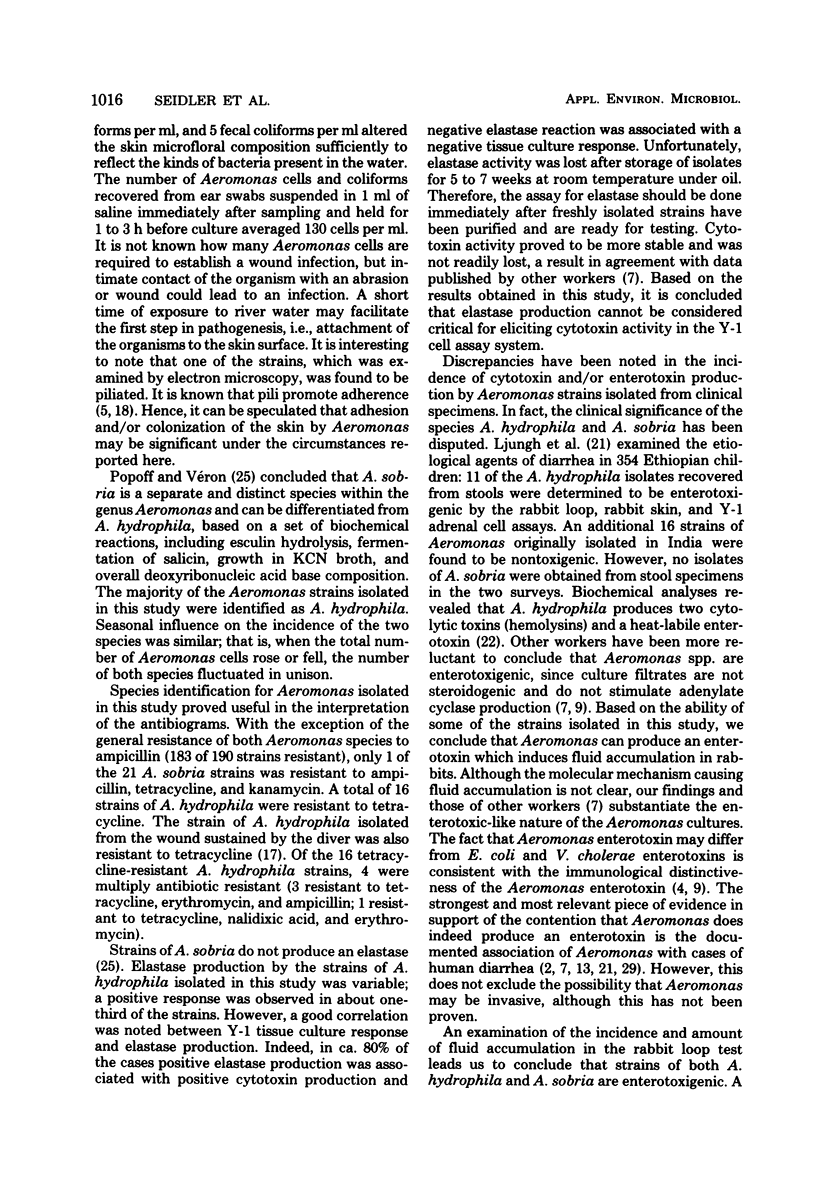
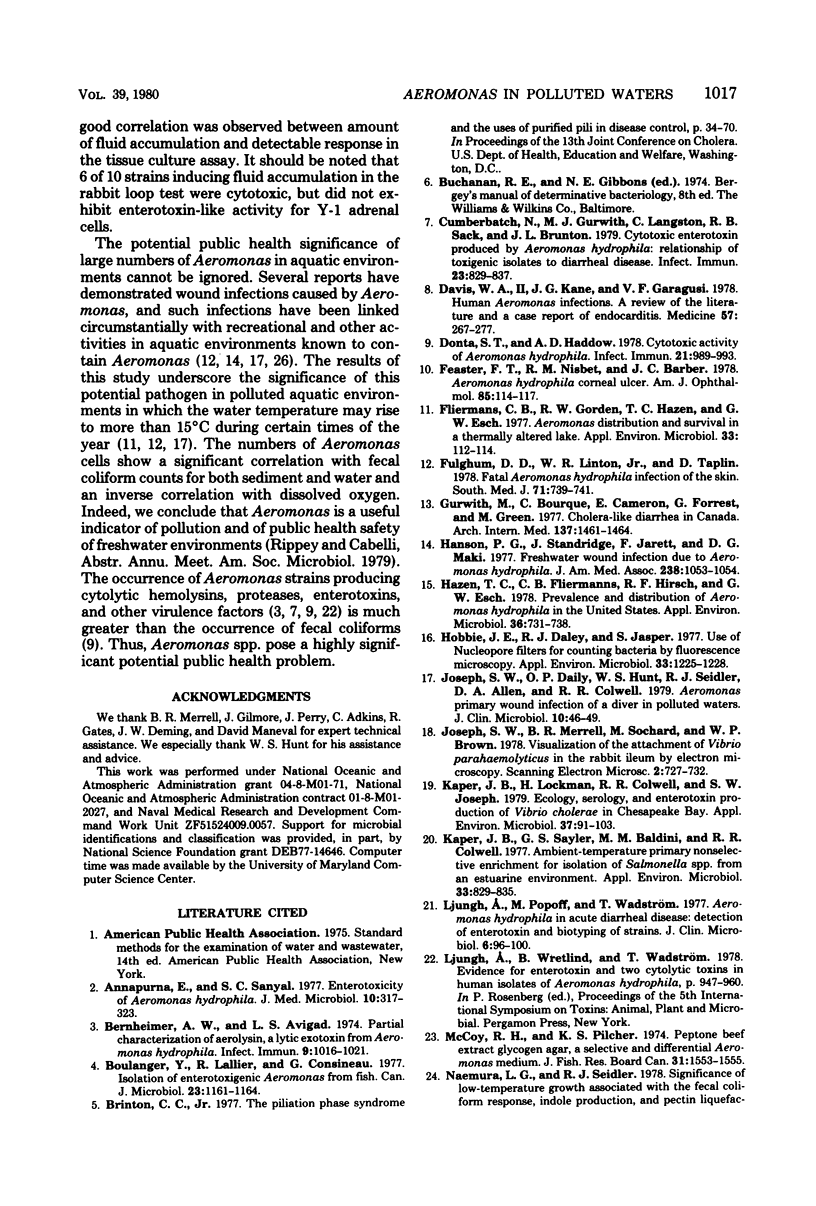

Selected References
These references are in PubMed. This may not be the complete list of references from this article.
- Annapurna E., Sanyal S. C. Enterotoxicity of Aeromonas hydrophila. J Med Microbiol. 1977 Aug;10(3):317–323. doi: 10.1099/00222615-10-3-317. [DOI] [PubMed] [Google Scholar]
- Bernheimer A. W., Avigad L. S. Partial characterization of aerolysin, a lytic exotoxin from Aeromonas hydrophila. Infect Immun. 1974 Jun;9(6):1016–1021. doi: 10.1128/iai.9.6.1016-1021.1974. [DOI] [PMC free article] [PubMed] [Google Scholar]
- Boulanger Y., Lallier R., Cousineau G. Isolation of enterotoxigenic Aeromonas from fish. Can J Microbiol. 1977 Sep;23(9):1161–1164. doi: 10.1139/m77-174. [DOI] [PubMed] [Google Scholar]
- Cumberbatch N., Gurwith M. J., Langston C., Sack R. B., Brunton J. L. Cytotoxic enterotoxin produced by Aeromonas hydrophila: relationship of toxigenic isolates to diarrheal disease. Infect Immun. 1979 Mar;23(3):829–837. doi: 10.1128/iai.23.3.829-837.1979. [DOI] [PMC free article] [PubMed] [Google Scholar]
- Davis W. A., 2nd, Kane J. G., Garagusi V. F. Human aeromonas infections: a review of the literature and a case report of endocarditis. Medicine (Baltimore) 1978 May;57(3):267–277. [PubMed] [Google Scholar]
- Donta S. T., Haddow A. D. Cytotoxic activity of Aeromonas hydrophila. Infect Immun. 1978 Sep;21(3):989–993. doi: 10.1128/iai.21.3.989-993.1978. [DOI] [PMC free article] [PubMed] [Google Scholar]
- Feaster F. T., Nisbet R. M., Barber J. C. Aeromonas hydrophila corneal ulcer. Am J Ophthalmol. 1978 Jan;85(1):114–117. doi: 10.1016/s0002-9394(14)76675-9. [DOI] [PubMed] [Google Scholar]
- Fliermans C. B., Gorden R. W., Hazen T. C., Esch G. W. Aeromonas distribution and survival in a thermally altered lake. Appl Environ Microbiol. 1977 Jan;33(1):114–122. doi: 10.1128/aem.33.1.114-122.1977. [DOI] [PMC free article] [PubMed] [Google Scholar]
- Fulghum D. D., Linton W. R., Taplin D. Fatal Aeromonas hydrophila infection of the skin. South Med J. 1978 Jun;71(6):739–741. doi: 10.1097/00007611-197806000-00037. [DOI] [PubMed] [Google Scholar]
- Gurwith M., Bourque C., Cameron E., Forrest G., Green M. Cholera-like diarrhea in Canada. Report of a case associated with enterotoxigenic Escherichia coli and a toxin-producing Aeromonas hydrophila. Arch Intern Med. 1977 Oct;137(10):1461–1464. doi: 10.1001/archinte.137.10.1461. [DOI] [PubMed] [Google Scholar]
- Hanson P. G., Standridge J., Jarrett F., Maki D. G. Freshwater wound infection due to Aeromonas hydrophila. JAMA. 1977 Sep 5;238(10):1053–1054. [PubMed] [Google Scholar]
- Hazen T. C., Fliermans C. B., Hirsch R. P., Esch G. W. Prevalence and distribution of Aeromonas hydrophila in the United States. Appl Environ Microbiol. 1978 Nov;36(5):731–738. doi: 10.1128/aem.36.5.731-738.1978. [DOI] [PMC free article] [PubMed] [Google Scholar]
- Hobbie J. E., Daley R. J., Jasper S. Use of nuclepore filters for counting bacteria by fluorescence microscopy. Appl Environ Microbiol. 1977 May;33(5):1225–1228. doi: 10.1128/aem.33.5.1225-1228.1977. [DOI] [PMC free article] [PubMed] [Google Scholar]
- Joseph S. W., Daily O. P., Hunt W. S., Seidler R. J., Allen D. A., Colwell R. R. Aeromonas primary wound infection of a diver in polluted waters. J Clin Microbiol. 1979 Jul;10(1):46–49. doi: 10.1128/jcm.10.1.46-49.1979. [DOI] [PMC free article] [PubMed] [Google Scholar]
- Kaper J. B., Sayler G. S., Baldini M. M., Colwell R. R. Ambient-temperature primary nonselective enrichment for isolation of Salmonella spp. from an estuarine environment. Appl Environ Microbiol. 1977 Apr;33(4):829–835. doi: 10.1128/aem.33.4.829-835.1977. [DOI] [PMC free article] [PubMed] [Google Scholar]
- Kaper J., Lockman H., Colwell R. R., Joseph S. W. Ecology, serology, and enterotoxin production of Vibrio cholerae in Chesapeake Bay. Appl Environ Microbiol. 1979 Jan;37(1):91–103. doi: 10.1128/aem.37.1.91-103.1979. [DOI] [PMC free article] [PubMed] [Google Scholar]
- Ljungh A., Popoff M., Wadstrom T. Aeromonas hydrophila in acute diarrheal disease: detection of enterotoxin and biotyping of strains. J Clin Microbiol. 1977 Aug;6(2):96–100. doi: 10.1128/jcm.6.2.96-100.1977. [DOI] [PMC free article] [PubMed] [Google Scholar]
- Popoff M., Véron M. A taxonomic study of the Aeromonas hydrophila-Aeromonas punctata group. J Gen Microbiol. 1976 May;94(1):11–22. doi: 10.1099/00221287-94-1-11. [DOI] [PubMed] [Google Scholar]
- Rosenthal S. G., Bernhardt H. E., Phillips J. A., 3rd Aeromonas hydrophila wound infection. Plast Reconstr Surg. 1974 Jan;53(1):77–79. doi: 10.1097/00006534-197401000-00015. [DOI] [PubMed] [Google Scholar]
- Rouf M. A., Rigney M. M. Growth temperatures and temperature characteristics of Aeromonas. Appl Microbiol. 1971 Oct;22(4):503–506. doi: 10.1128/am.22.4.503-506.1971. [DOI] [PMC free article] [PubMed] [Google Scholar]
- SMITH H. L., Jr, GOODNER K. Detection of bacterial gelatinases by gelatin-agar plate methods. J Bacteriol. 1958 Dec;76(6):662–665. doi: 10.1128/jb.76.6.662-665.1958. [DOI] [PMC free article] [PubMed] [Google Scholar]
- Sack D. A., Sack R. B. Test for enterotoxigenic Escherichia coli using Y-1 adrenal cells in miniculture. Infect Immun. 1975 Feb;11(2):334–336. doi: 10.1128/iai.11.2.334-336.1975. [DOI] [PMC free article] [PubMed] [Google Scholar]
- Sanyal S. C., Singh S. J., Sen P. C. Enteropathogenicity of Aeromonas hydrophila and Plesiomonas shigelloides. J Med Microbiol. 1975 Feb;8(1):195–198. doi: 10.1099/00222615-8-1-195. [DOI] [PubMed] [Google Scholar]
- Schwarz J. R., Colwell R. R. Effect of hydrostatic pressure on growth and viability of Vibrio parahaemolyticus. Appl Microbiol. 1974 Dec;28(6):977–981. doi: 10.1128/am.28.6.977-981.1974. [DOI] [PMC free article] [PubMed] [Google Scholar]
- Shotts E. B., Jr, Rimler R. Medium for the isolation of Aeromonas hydrophila. Appl Microbiol. 1973 Oct;26(4):550–553. doi: 10.1128/am.26.4.550-553.1973. [DOI] [PMC free article] [PubMed] [Google Scholar]
- Tenney J. H., Smith T. F., Washington J. A., 2nd Sensitivity, precision, and accuracy of the Y1 adrenal cell enterotoxin assay. J Clin Microbiol. 1979 Feb;9(2):197–199. doi: 10.1128/jcm.9.2.197-199.1979. [DOI] [PMC free article] [PubMed] [Google Scholar]


